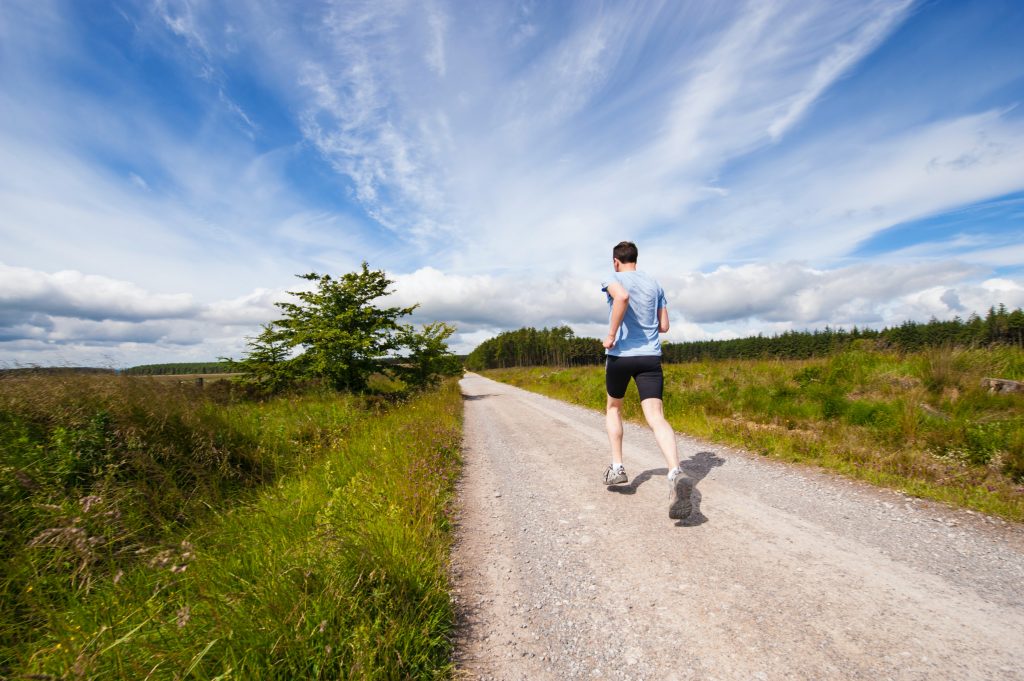
Depression has a significant impact on people’s lives, and is a major contributor to the non-fatal disease burden globally (Rehm and Shield 2019). Major life stressors, such as job loss, marital break-up, bereavement or significant injury, are potent influences for causing depression (Hammen 2005). However, people respond to life stressors differently: people with more adaptive/constructive coping mechanisms may not be as adversely affected as others (Beasley, Thompson et al. 2003), and people who have more positive influences in their life, such as social support and healthy lifestyle, may be more resilient and ‘bounce back’ after stressful events (Windle 2011). Identifying the factors related to better mental health during and after stressful events is critical for public mental health guidelines.
Physical activity can improve mental health and reduce symptoms of depression and anxiety (Firth, Solmi et al. 2020). Engaging in exercise can also impact our self-perceptions: regular exercise behaviour can improve our self-efficacy (McAuley and Blissmer 2000) (belief in our ability to ‘rise to the challenge’), and evaluation of group-based exercise programs for people with mental illness have demonstrated improved self-worth and hope after engaging in the exercise program (Whybird, Z. et al. 2020). These improvements to mental health and self-perceptions combined with other physiological benefits of physical activity may be associated with resilience to life stressors; however, few studies have investigated the longitudinal relationship between physical activity and response to life stressors.
The aim of the study being reviewed was to investigate whether exercise prior to a stressful life event ‘buffered’ depressive symptoms after the event (Szuhany et al, 2023).

Exercise has diverse benefits to health and wellbeing, and can help us get the most out of life and deal with its challenges. But can it prevent adverse reactions to stressful life events?
Methods
A longitudinal dataset from the Health and Retirement Study was used to examine the relationship between self-reported exercise and depressive symptoms before, and after, stressful life events.
Participants were 1,405 US adults aged 50+ years who completed outcome measures every two years between 2004 and 2016. All participants reported a significant life event during this period, including bereavement, disability onset, job loss, divorce, and myocardial infarction. The most common of these was ‘disability’ which was reported by more than a third of the sample depending on participant category (unclear how disability was assessed).
A ‘floating baseline method’ was used to map self-reported exercise and depressive symptoms relative to the stressful event: Time 0 (T0) was the assessment immediately prior to the event, and subsequent assessments (T1 and T2) immediately followed the event. ‘Trajectories’ of depressive symptoms were mapped onto four distinct clusters: (i) resilient group who had consistently low depression; (ii) improving group who had depressive symptoms that reduced after the event; (iii) chronic group who had consistently high depression; and (iv) emerging group whose depressive symptoms increased after the event.
Results
Higher levels of exercise at baseline predicted greater likelihood of being in the resilient trajectory group compared with other groups. However, after controlling for covariates, baseline exercise only predicted the greater likelihood of being in the resilient group compared with the improving group. That is, higher levels of exercise at baseline did not affect the likelihood of being in the resilient group as compared to the emerging or chronic group.
Repeated measures analysed indicated that exercise was associated with trajectory group over time, as well as covariates age, mobility, race and education years. Previous studies have demonstrated an association between age, education and exercise, and one’s mobility is logically related to activity, so it may not be surprising that these covariates were associated with exercise. Race can be associated with cultural norms, experienced stigma, and socioeconomic influences, all of which can impact physical activity behaviour. The trajectory groups were defined by their depressive symptoms, so the association between group and time even when including covariates in the model indicates a potential relationship between exercise and depression.
Analyses suggested potential differences in exercise between groups at the different time points. Baseline exercise was mostly similar between groups: the only significant difference was that exercise score in the improving group was lower than the resilient group. Mean self-reported exercise generally decreased for all groups over time. The chronic and emerging groups had the greatest decrease in exercise over time, and by T2, the resilient and improving groups had higher exercise levels.

Exercising led to a greater likelihood of being categorised as ‘resilient’ to depression after a stressful life event, compared with having an ‘improvement’ in depression following a stressful life event.
Conclusions
This research suggests that regular exercise may buffer against depression following stressful life events, and increasing exercise after these events may also help.

In science it’s always “maybe”… here exercise definitely maybe has an impact on how people may experience depression over time while experiencing stressful life events.
Strengths and limitations
Strengths are a large sample size and robust data set. It was unclear exactly what criteria were applied to categorise the different trajectory groups, but looking at the associated citation of their fancy polygenic risk scoring method (Schultebraucks, Choi et al. 2021), they appear to have had a lot more robust data to determine the clusters. The error bars in Figures 1 and 2 are unusually tight for self-reported mental health and physical activity data – which would indicate the clusters are very well defined… but I still find this hard to believe because real world data is rarely this clean. Age, race, education and mobility were included as biological and social covariates, which adds some robustness to the analysis.
A limitation is the lack of measurement of resilience or other factors related to depression (e.g. social connection/isolation, Zenebe, Akele et al. 2021). The narrative of the paper was clearly written about resilience, but because there was no direct measure of resilience the assumption is that lack of depression equals resilience. This doesn’t take into account differences in the life event (e.g., positive consequences resulting from the event – see Hardy, Concato et al. 2002), or the fact that people respond to stressors differently (e.g. anxiety symptoms rather than depression). It was also unclear whether the number of life events in between T0 and T1 were considered (e.g., job loss and divorce), or whether life events experienced between T1 and T2 were considered.
The lack of inclusion of other covariates in the model is another limitation. As mentioned above, information about the stressful life events were not included in the models. The potential link between exercise and resilience to life events can therefore only be interpreted in the context of the study design, which analysed participant data around the life event. The assumption inherent in this is that the stressful life events (that were measured) have the same/similar impact on depression. It would have been interesting to see the results if the type of life event was investigated in the model. Further, the covariates were decided based on their association with exercise at each timepoint, and variables such as BMI or stroke history weren’t included as a covariates because they were only associated with exercise at one or two timepoints. This doesn’t seem logical given that the primary analysis was related to predicting depression trajectory. BMI has been shown to be associated with depression (Luppino, de Wit et al. 2010), and they had a big enough sample size to include other covariates, so it’s difficult to understand why the model didn’t include more of the data.

Resilience has a broader definition than just the absence of depression and is dependent upon other social factors as well as the type of life event.
Implications for practice
Physical activity and exercise can reduce depression, so helping people be more active improves mental health, which is also pertinent for when people face challenges in life. In general, exercise should be advised in public mental health guidelines. Support to be physically active should be a fundamental service in a society that values the wellbeing and productivity of its citizens, particularly for people experiencing vulnerability or marginalisation.

Exercise combined with other positive social and lifestyle influences should be encouraged to promote mental health.
Statement of interests
Justin Chapman is a card-carrying physical activity activist and implementation scientist who likes to throw in a self-citation here and there…
Check out Justin’s #EquallyWellAu23 live blog if you want more of the latest evidence about promoting physical health in people living with mental health difficulties.
Links
Primary paper
Szuhany, K. L., M. Malgaroli and G. A. Bonanno (2023). “Physical activity may buffer against depression and promote resilience after major life stressors.” Mental Health and Physical Activity 24: 100505.
Other references
Beasley, M., T. Thompson and J. Davidson (2003). “Resilience in response to life stress: the effects of coping style and cognitive hardiness.” Personality and Individual differences 34(1): 77-95.
Firth, J., M. Solmi, R. E. Wootton, D. Vancampfort, F. B. Schuch, E. Hoare, S. Gilbody, J. Torous, S. B. Teasdale and S. E. Jackson (2020). “A meta‐review of “lifestyle psychiatry”: the role of exercise, smoking, diet and sleep in the prevention and treatment of mental disorders.” World psychiatry 19(3): 360-380.
Hammen, C. (2005). “Stress and depression.” Annu. Rev. Clin. Psychol. 1: 293-319.
Hardy, S. E., J. Concato and T. M. Gill (2002). “Stressful life events among community‐living older persons.” Journal of General Internal Medicine 17(11): 841-847.
Luppino, F. S., L. M. de Wit, P. F. Bouvy, T. Stijnen, P. Cuijpers, B. W. Penninx and F. G. Zitman (2010). “Overweight, obesity, and depression: a systematic review and meta-analysis of longitudinal studies.” Archives of general psychiatry 67(3): 220-229.
McAuley, E. and B. Blissmer (2000). “Self-efficacy determinants and consequences of physical activity.” Exercise and sport sciences reviews 28(2): 85-88.
Rehm, J. and K. D. Shield (2019). “Global burden of disease and the impact of mental and addictive disorders.” Current psychiatry reports 21: 1-7.
Schultebraucks, K., K. W. Choi, I. R. Galatzer-Levy and G. A. Bonanno (2021). “Discriminating heterogeneous trajectories of resilience and depression after major life stressors using polygenic scores.” JAMA psychiatry 78(7): 744-752.
Whybird, G., N. Z., E. Savage, N. Korman, S. Suetani, E. Hielscher, G. Vilic, S. Tillston, S. Patterson and J. Chapman (2020). “Promoting quality of life and recovery in adults with mental health issues using exercise and nutrition interventions ” International Journal of Mental Health.
Windle, G. (2011). “What is resilience? A review and concept analysis.” Reviews in clinical gerontology 21(2): 152-169.
Zenebe, Y., B. Akele and M. Necho (2021). “Prevalence and determinants of depression among old age: a systematic review and meta-analysis.” Annals of general psychiatry 20(1): 1-19.
Photo credits
- Photo by Matt Heaton on Unsplash
- Photo by Jenny Hill on Unsplash
- Photo by Alex Shute on Unsplash
- Photo by Caroline Hall on Unsplash
- Photo by Warren on Unsplash
- Photo by Kelly Sikkema on Unsplash
